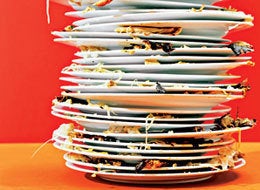
I've given up on the US government's food pyramid and its heavy emphasis on carbohydrates. In my opinion it is a medical disaster. Instead, I recommend that you choose the best foods for your brain type.
On my web site you can take a simple brain quiz to see which of the four brain chemicals you are lacking. Then, you can choose from a wide variety of fresh foods, herbs, spices and teas that will actually help you to lose weight and keep those pounds from coming back. These foods have been specially chosen to create long-lasting satiety so you won't feel hungry. They also promote excellent brain chemistry, so you will have an increased sense of well-being and high energy. Many have dopamine-boosting properties, so they increase your metabolism and curb your cravings. High acetylcholine foods reduce your need for "bad" fats. High GABA foods alleviate stress and enable you to have better portion control. High serotonin foods allow you to get the rest you need to recharge your brain and body.
I also classify foods in a few distinct, yet broader categories: expanding foods and balanced foods. Expanding foods are those that have extreme effects on the body and cause a seemingly positive short-term effect (an energy boost) while creating a nutritional disaster over time. Once we start to eat expanding foods, we find ourselves craving more of them to restore our energy. Simple carbohydrates, refined foods, or "white foods" are all expanding foods because they boost our energy in the short term but often create food cravings, dopamine deficiencies, and worse, food addictions. These are foods that can zap energy and attention, and make us feel "flighty."
These are all the dieting "pitfalls" that you probably knew you weren't supposed to eat. Now you know the real reason. It's not just that they are packed with calories; they are literally making you older as they make you fatter. Foods in this category include:
•Processed foods (fast food, "just add water" mixes)
•Foods high in sugar (candy, "health" bars, sweetened breakfast cereals, fruit juices, sweetened tea beverages)
•White bread (French bread, sourdough, bagels, English muffins)
•Foods made from white flour (cookies, cakes, muffins, pancakes, waffles)
•White rice
•Pastas
•Fried foods (French fries, potato pancakes, fried chicken, fried fish)
•Foods filled with saturated fats (donuts, pizza, cheeseburgers)
•High fat proteins, like steak or untrimmed meats and poultry
•Foods high in salt
In order to stay younger (and get thinner) you need to focus on foods that are balanced, and a dinner plate that is balanced. Our bodies still need carbohydrates, fats and proteins in order to stay healthy. Each of your three meals, plus one snack, should be at least 70% plant based and no more than 30% animal based. The best way to stave off cravings is by eating complex carbohydrates like whole grains and vegetables with small amounts of animal products. One good rule I've recently heard is if you think of your plate as a clock, your protein should take up the space allotted between 12:00 and 2:00.
At the same time, start substituting your old bad choices in the expanding category for fresh foods that fall within the middle of the food spectrum. Moderate portions of lean meats, fish, and poultry are all in the range of balanced foods. So are whole grains like millet, brown rice, barley, corn, oats, quinoa and buckwheat. These foods are absorbed slowly by the body, keeping glucose and insulin low and providing long-lasting energy. They provide the unique ability to prevent the steep declines in blood sugar levels that give rise to fatigue, mood swings and food cravings.
How Much Sugar Can I Have?
Although sugar is not considered a balanced food, many balanced foods, like fruits, contain natural sugars that need to be monitored. According to the World Health Organization, no more than 10 percent of calories should come from sugars. That translates to a maximum of 12 teaspoons of sugar (48 grams) in a 2,200-calorie diet. However, a weight loss regimen based on 1800 calories a day means that you should have no more than nine teaspoons or 36 grams of sugar a day.
Read nutrition labels on packaged foods, even if they are considered balanced, because sugar adds up fast. A single bowl of Frosted Mini Wheats contains three teaspoons (12 grams) of sugar; some raisin brans contain 20 grams; and a 20-ounce fruit drink can pack nearly 18 teaspoons (71 grams) of sugar. And be sure to count the "hidden" sources of sugar, too -- soups, pasta sauce, and even salad dressings may contain lots of added sugar.
Fruits are balanced foods that can be packed with natural sugars. Take these numbers into consideration as you are planning your day's worth of sugar.
FruitGrams of Sugar per serving
Apple 11.8
Apricot 8.0
Banana 20.4
Blackberry 8.0
Blueberry 11.0
Cantaloupe 6.3
Cherries 13.0
Dates 73.0
Figs 19.0
Grapefruit 6.6
Grapes 15.5
Kiwi 8.8
Mango 15.0
Orange 10.6
Papaya 8.0
Peach 7.9
Pear 11.5
Pineapple 12.0
Plum 9.6
Pomegranate 17.0
Strawberry 5.1
Watermelon 8.0